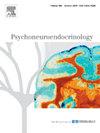Intranasal oxytocin increases cooperation of heterosexual men with women
IF 3.6
2区 医学
Q2 ENDOCRINOLOGY & METABOLISM
引用次数: 0
Abstract
Sexualization may lead to sexual objectification, which is thought to be the prelude of misogynistic behavior. On the other hand, sexualization can also increase approach and courtship from the opposite sex. It is still unclear how the sexualization of women biases social cooperative decisions towards them. In an EEG experiment with the Prisoner’s Dilemma, using a between-subject double-blind placebo-controlled design, we investigated if the sexualization of women could influence cooperative behaviors from heterosexual men (n = 50) and if oxytocin (OT), thought to have a key role in social cognition, modulates this effect. We found sexualized women were perceived as more attractive, sexy, and sexually available, and less moral but not objectified. Our main finding was that OT pervasively increased general cooperation probability, as well as cooperation probability specifically after reciprocal cooperation. Additionally, OT increased cooperation probability after betrayal, particularly for non-sexualized and when they played before the sexualized women. Neurally, we found sexualization affected P300 and FRN responses during the game’s outcomes, and that the former’s latency was also increased by OT when men played with non-sexualized before the sexualized women, tentatively reflecting the above behavioral results. Our findings corroborate existing theories of OT increasing trust and rendering prosocial or pro-approach behavior rewarding and extend them to the context of the other’s sexualization.
鼻内催产素增加异性恋男性与女性的合作
性化可能导致性物化,这被认为是厌恶女性行为的前奏。另一方面,性化也可以增加异性的接近和求爱。目前尚不清楚女性的性别化是如何使社会合作决策对她们产生偏见的。在囚徒困境的脑电图实验中,我们使用受试者之间的双盲安慰剂对照设计,研究女性的性化是否会影响异性恋男性的合作行为(n = 50),以及被认为在社会认知中起关键作用的催产素(OT)是否会调节这种影响。我们发现,性化的女性被认为更有吸引力、更性感、更容易获得性,道德水平更低,但不会被物化。我们的主要发现是,OT普遍增加了一般合作概率,特别是在互惠合作之后的合作概率。此外,OT增加了背叛后的合作概率,特别是对于非性化和在性化的女性之前玩游戏的人。在神经方面,我们发现在游戏结果中,性化会影响P300和FRN的反应,并且当男性在性化女性之前与非性化女性玩游戏时,前者的潜伏期也会因OT而增加,初步反映了上述行为结果。我们的研究结果证实了现有的理论,即OT增加信任,使亲社会或亲接近行为得到奖励,并将其扩展到他人的性化背景。
本文章由计算机程序翻译,如有差异,请以英文原文为准。
求助全文
约1分钟内获得全文
求助全文
来源期刊

Psychoneuroendocrinology
医学-精神病学
CiteScore
7.40
自引率
8.10%
发文量
268
审稿时长
66 days
期刊介绍:
Psychoneuroendocrinology publishes papers dealing with the interrelated disciplines of psychology, neurobiology, endocrinology, immunology, neurology, and psychiatry, with an emphasis on multidisciplinary studies aiming at integrating these disciplines in terms of either basic research or clinical implications. One of the main goals is to understand how a variety of psychobiological factors interact in the expression of the stress response as it relates to the development and/or maintenance of neuropsychiatric illnesses.
 求助内容:
求助内容: 应助结果提醒方式:
应助结果提醒方式:


